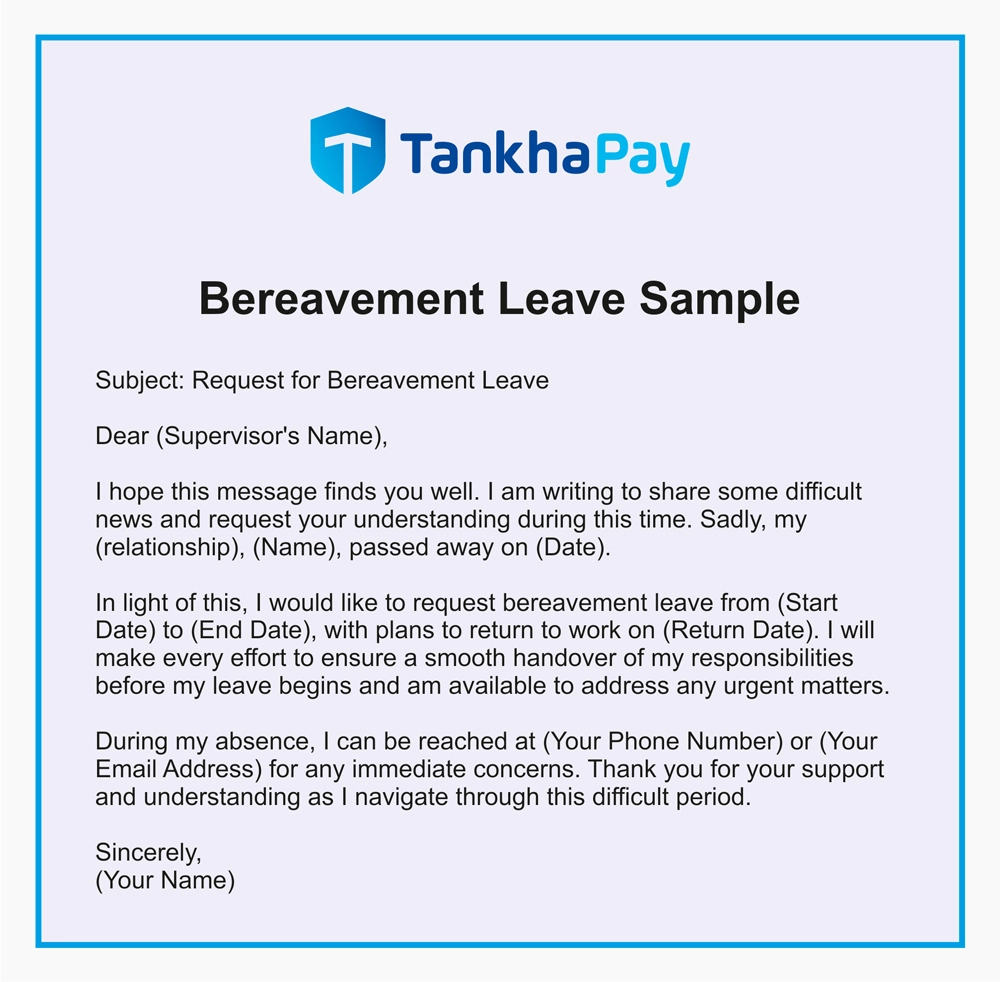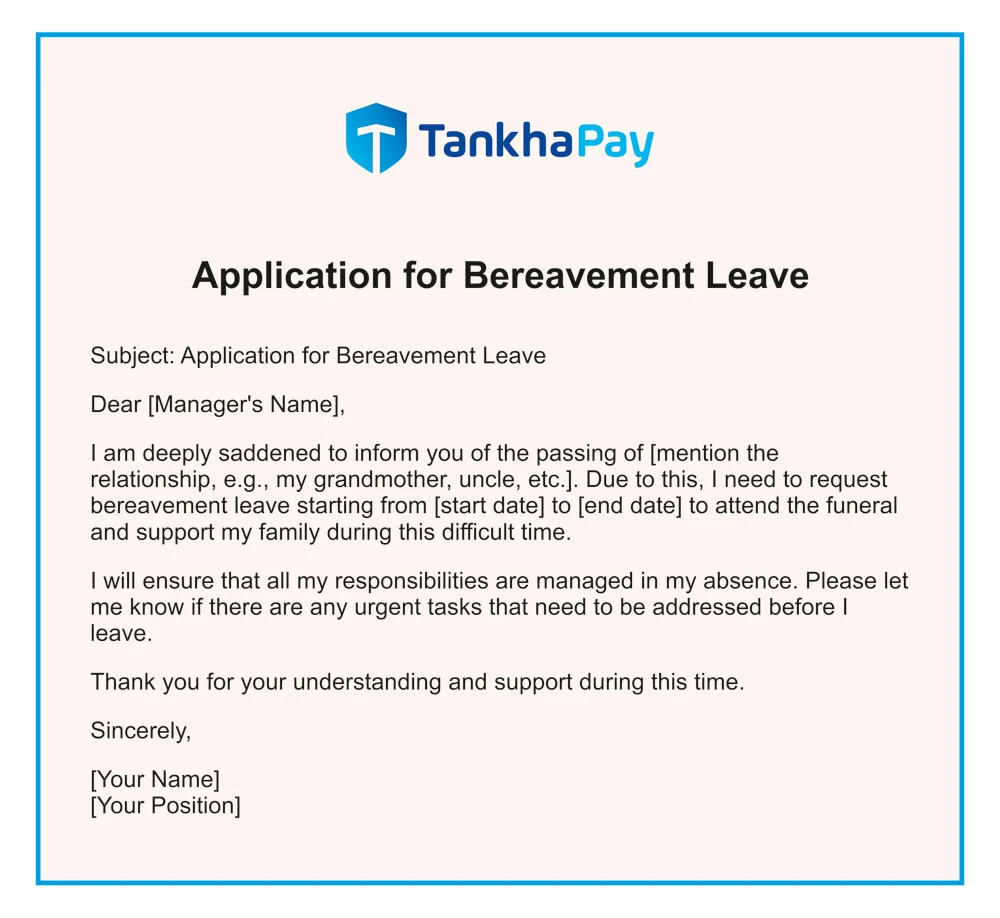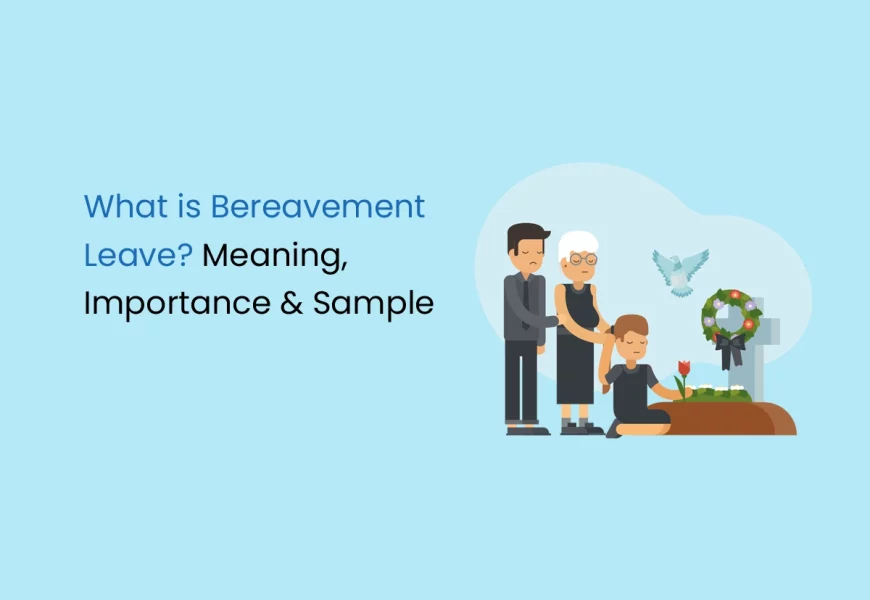Bereavement leave is paid leave granted when an employee loses someone close to them. This can be the loss of any close relationship—a family member, sibling, child, spouse, or close friend.
As an employer, it’s essential to acknowledge that there may come a time when your employees need to take leave to grieve the loss of a loved one, make funeral arrangements, or manage other related matters. To support them during this difficult period, many employers have established bereavement leave policies. In this article, we will define bereavement leave, outline how to request time off, and address common questions regarding policy rules.
What is Bereavement Leave?
Bereavement Leave is paid leave an employer provides to employees after losing a loved one, such as a family member, relative, spouse, or sibling. This leave allows the employee time to cope with the emotional impact of the loss and make necessary arrangements. To avail of bereavement leave, the employee should inform their employer immediately after the death occurs.
While bereavement leave is not mandatory by law in many organisations, it is generally offered as a gesture of care and sympathy. Typically, employers grant three days of bereavement leave, though this duration may vary. Employees should discuss the days needed with their employer or reporting manager based on their circumstances.
Importance of Bereavement Leave
Employees can use their bereavement leave to spend time with family members and friends who are also grieving. This type of leave is often taken to make funeral arrangements and attend memorial services.
Below are some common reasons why bereavement leave is important:
Mourn the Loss
The grieving process varies from person to person. Bereavement leave policies recognize this by allowing employees time to come to terms with the loss of a loved one. The number of days granted depends on the employer’s policy. This leave provides employees with the necessary time to grieve, reflect, and support one another alongside family and friends.
Make Necessary Funeral Arrangements
Some employees may require additional time off to handle important funeral arrangements and related responsibilities. A bereavement leave policy supports this need by allowing sufficient time for employees to manage these tasks. In some cases, the policy may also provide flexibility or extensions to help employees meet other personal commitments during this difficult period.
Attend the Funeral Ceremony
A bereavement leave policy provides employees with sufficient time to attend the funeral ceremony and fulfill related commitments, including memorial services. In addition to allowing attendance at these important events, the policy also offers time to begin coping with the emotional impact of the loss. Typically, bereavement leave lasts for three days, but it may be extended to five days or even several weeks, depending on the organization’s policy and the employee’s specific circumstances.
Recover from the Loss
In addition to coping with the emotional impact of losing a loved one, some organizations provide employees with adequate time to recover from the trauma and shock of the event. Many employees benefit from having a few extra days to be with their family, process their grief, and gradually regain a sense of normalcy in their personal lives before returning to work.
To Support Employees
Although bereavement leave is not mandatory in many countries, it is often offered as part of employee well-being initiatives. Providing this leave helps create a supportive work environment, allowing employees to balance their personal and professional lives more effectively during difficult times.
How To Write a Bereavement Leave Letter
Here’s a step-by-step guide to writing a bereavement leave request that is both respectful and clear, ensuring a smooth communication process with your supervisor or HR.
- Subject Line: The subject line should immediately convey the purpose of the email.
Example: “Request for Bereavement Leave” - Salutation: Address your email appropriately. Begin by addressing your direct supervisor or HR manager with a formal greeting.
Example: “Dear (Supervisor’s Name),” - Opening Statement: State the purpose of the email upfront. Start with a brief and respectful statement about why you are writing.
Example: “I am writing to inform you of a personal matter that requires my immediate attention and your understanding.” - Explain the Situation: Provide the necessary context. Gently explain the reason for your request, including the relationship and details of the bereavement.
Example: “I am saddened to inform you of the passing of my (relationship), (Name), on (Date).” - Request for Leave: Specify the dates and duration. Clearly state the period you will be absent and when you expect to return to work.
Example: “I am requesting bereavement leave from (Start Date) to (End Date), returning to work on (Return Date).” - Offer to Assist with Transition: Ensure continuity of responsibilities. Demonstrate your willingness to assist with any necessary preparations before your leave, reassuring your supervisor that you’ve considered the impact of your absence.
Example: “I will do my best to ensure a smooth transition of my responsibilities during my absence. I am available to discuss any urgent matters before my leave.” - Provide Contact Information: Stay reachable for emergencies. Include your contact details should any urgent issues arise during your time away.
Example: “I can be reached at (Your Phone Number) or (Your Email Address) during my leave for any urgent matters.” - Closing Statement: End your email with a polite expression of gratitude for their support during this challenging time.
Example: “Thank you for your understanding and support during this difficult time.” - Sign-Off: Finish with an appropriate and formal sign-off.
Example: “Sincerely, (Your Name)”
Bereavement Leave Application Format
A bereavement leave application will help you approach this topic with professional courtesy, but if you find yourself struggling to write one, this format will help you out.
Dear (Supervisor’s Name),
I hope this message finds you well. I am writing to share some difficult news and request your understanding during this time. Sadly, my (relationship), (Name), passed away on (Date).
In light of this, I would like to request bereavement leave from (Start Date) to (End Date), with plans to return to work on (Return Date). I will make every effort to ensure a smooth handover of my responsibilities before my leave begins and am available to address any urgent matters.
During my absence, I can be reached at (Your Phone Number) or (Your Email Address) for any immediate concerns. Thank you for your support and understanding as I navigate through this difficult period.
Sincerely,
(Your Name)

Bereavement Leave Application For Office
When dealing with the loss of a loved one, taking time off is often necessary to cope with the situation and make arrangements. A 5-day bereavement leave application allows you to formally request time off to grieve and handle any associated responsibilities. By submitting a respectful and clear application, you can ensure your request is processed efficiently during this difficult time.
Below, we have provided a sample of a bereavement leave application that can serve as a guide for your own.
HR Manager
AKAL Info
Subject: Bereavement Leave Application
Dear Aaryaan,
I hope this message finds you well. It is with deep sadness that I inform you of the passing of my dear mother last night. In this difficult time, I need to head home to support my family and take care of the funeral arrangements. Therefore, I humbly request your approval for a 5-day paid bereavement leave, starting today, the 21st of November, 2025, and ending on the 25th of November, 2025.
I will be reachable on my cell phone if you need to contact me. Additionally, I have informed Prakriti Bose, a colleague, about my responsibilities, and she will be able to assist you in my absence.
I sincerely apologise for any inconvenience this may cause and appreciate your understanding and support during this challenging period.
Thank you for your consideration.
Warm regards,
Priya Varsha
Content Strategist
Digital Marketing Team
AKAL Info

How Does Bereavement Leave Work?
While many companies do provide bereavement leave policies, the expectations and eligibility criteria can vary significantly from one organisation to another. In some instances, bereavement leave is included under broader categories such as sick leave, vacation policies, or even Family and Medical Leave.
Here’s a closer look at how bereavement leave typically operates within workplaces:
- Employees often require varying lengths of time to cope with their loss emotionally and to fulfil personal commitments arising from the situation. As such, bereavement leave can be quite flexible, with some organisations offering a standard period of around five days, while others may extend this duration to as much as 12 weeks, recognising that grief does not adhere to a strict timeline.
- Eligibility criteria for bereavement leave can differ, with some companies limiting this benefit to full-time employees only, while others may extend it to part-time staff as well. This ensures that all employees, regardless of their employment status, are supported during such a challenging time.
- In certain cases, organisations might require employees to provide specific information regarding the death, complete necessary documentation, and, in some instances, submit a death certificate if requested. This requirement can help establish the context for the leave and ensure that policies are adhered to consistently.
- The financial aspect of bereavement leave can also vary widely. Some organisations offer paid leave, while others may provide unpaid leave, with decisions typically influenced by the duration of the leave taken. Depending on the company’s policy, there may even be a combination of both paid and unpaid leave, allowing for some flexibility based on individual circumstances.
- Regardless of whether bereavement leave is mandated by law, employees are encouraged to engage in open discussions with their employers about taking time off to heal from their loss. This dialogue can foster a supportive atmosphere, allowing employees to express their needs during an emotionally taxing period.
- Furthermore, it is important to note that bereavement leave policies are often revised and updated to meet the evolving needs of employees, thus helping to mitigate any potential claims of workplace discrimination. By staying attuned to employee requirements, organisations can ensure their policies remain relevant and fair.
The HR department plays a crucial role in this process, providing additional support services and assistance programmes that can help employees navigate their grief and the practicalities associated with it. This holistic approach not only benefits the individual employee but also strengthens the organisation as a whole by fostering a compassionate and understanding workplace culture.
Applying for a Bereavement Leave
Applying for bereavement leave can be a crucial step in managing the emotional upheaval that follows the loss of a loved one. This process can often feel daunting, particularly when one is dealing with grief. To ensure a smooth application for bereavement leave, employees should follow these key steps:
1. Inform the employer as soon as possible
In the wake of a loved one’s passing, fulfilling professional commitments can become incredibly challenging. Therefore, it is essential to notify your employer or relevant manager at the earliest opportunity. This prompt communication enables the necessary paperwork to be processed quickly and allows your colleagues to prepare for any redistribution of your workload. Being proactive not only helps maintain workplace efficiency but also demonstrates professionalism during a difficult time.
2. Use a leave management system
Many organisations require employees to submit their leave requests via traditional methods such as letters or emails. However, this approach can complicate the management of time-off requests, leading to potential inefficiencies in workload distribution and creating the risk of payroll errors and legal compliance issues. Implementing a leave management system, such as TankhaPay, can significantly streamline this process. Such systems enable easy tracking of employee leave, shift timings, and holidays, while also automating payroll processes to minimise errors.
3. Discuss the duration of leave
Given that different companies have various policies regarding bereavement leave, it is essential for employees to engage in a discussion with their employers to determine the appropriate duration of leave needed. While some organisations may offer a fixed number of days, others may be more flexible and open to extending the leave based on individual circumstances. It is in the best interest of organisations to regularly review and update their leave policies to prevent any potential claims of workplace discrimination and ensure fair treatment for all employees.
4. Complete the necessary paperwork
Applying for bereavement leave often involves some degree of paperwork. Employees may be required to fill out forms related to the death certificate or provide other documentation as stipulated by company policy. This may include submitting copies of obituaries or travel itineraries if relevant. To prevent any delays in the approval of your leave, it is crucial to complete and submit these forms promptly. Many modern organisations utilise leave management systems, like TankhaPay, to digitise and simplify the paperwork process, making it easier for employees to navigate.
5. Have someone assist with your workload
Given the unexpected nature of bereavement leave, it is unlikely that every employee will be able to complete all their existing duties before taking time off. Therefore, it is advisable to arrange for a colleague to assist with your responsibilities during your absence. By coordinating with a co-worker to cover your workload for a few days, you can ensure that essential tasks are managed while you take the necessary time to grieve and recover.
Employees can navigate the application process for bereavement leave with greater ease, allowing them to focus on their emotional well-being during such a challenging time. This thoughtful approach not only aids in individual recovery but also promotes a supportive workplace culture that values the needs of its employees.
Drafting a Bereavement Policy
A typical bereavement leave policy generally outlines several key components to guide both employees and employers through the process during a difficult time. These sections commonly include:
Guidelines
This section provides essential information on what bereavement leave can be used for. It typically covers attending the funeral, handling financial or personal affairs related to the deceased, and allowing time to recover emotionally and mentally. The purpose is to give employees the necessary time and space to cope with their loss and manage practical arrangements.
Eligibility
The eligibility criteria determine which employees can utilise bereavement leave. Some companies may restrict this benefit to full-time employees, while others may offer it to part-time or contract staff. Eligibility might also be limited to specific relationships, such as immediate family members, including spouses, children, parents, or siblings. This section clarifies who qualifies for the leave.
Procedures
This part of the policy outlines how to request bereavement leave. Employees are often required to inform their employer or HR department as soon as possible following the death of a loved one. The procedures section may also detail any documents or forms that need to be submitted, such as a death certificate or obituary, to ensure proper record-keeping. Additionally, it may include information on how to apply for extended or additional unpaid leave if necessary.
Duration
The duration of bereavement leave can vary depending on the company’s policy. Some organisations may offer a set number of paid days, which could range from three to five days, while others might allow employees to extend their leave using unpaid time off. Understanding this aspect of the policy helps employees plan for their absence and gives them clarity about how long it can take to grieve and settle any personal matters.
Having a clear understanding of your company’s bereavement leave policy ensures you are informed of your rights and responsibilities during difficult times, helping you manage both your professional and personal obligations with greater ease.
What Happens After Bereavement Leave?
When the time comes to return to work after taking compassionate leave, it’s crucial to keep the lines of communication open with your employer. As you prepare to resume your professional responsibilities, it’s beneficial to agree in advance on how frequently you should stay in touch during your absence. Discuss whether these check-ins will take place via email, phone calls, or face-to-face meetings, ensuring that you remain informed and supported throughout your time away.
Employers should ideally have a structured policy for reintegrating employees into the workplace following a period of leave. This policy should outline the process for returning to work and provide support to ease the transition. As an employee, it is also prudent to take a proactive approach. Consider requesting a discussion about any updates or changes that may have occurred during your absence, as well as any new responsibilities you should be aware of before your first day back. This can help you feel more prepared and less overwhelmed as you adjust to returning to the workplace.
Moreover, if you find yourself grappling with anxious thoughts regarding life’s uncertainties as you re-enter the working environment, it’s important to remember that while you cannot control unfortunate events such as accidents or illnesses, there are proactive measures you can take to mitigate potential risks. Ensuring that you have comprehensive health insurance, personal accident insurance, and/or coverage for critical illness can significantly contribute to your peace of mind. Being well-insured means that you are better equipped to handle unforeseen circumstances, alleviating the financial strain that may accompany challenging times. Taking these precautionary steps can help you feel more secure about your future, allowing you to focus on your work and personal life with greater confidence.
FAQs on Bereavement Leave
What proof is required for bereavement leave?
In most cases, companies do not require formal proof of death when an employee applies for bereavement leave. However, employers may seek to verify the occurrence of the death to ensure that the leave is being used appropriately. This verification process may involve asking for basic details such as the name of the deceased, the date of death, and the nature of the relationship between the employee and the deceased. Additionally, some organisations may request supplementary documentation, such as an obituary or a funeral programme, to substantiate the claim for bereavement leave.
Is it mandatory for companies to provide bereavement leave?
There is no universal requirement for employers to offer bereavement leave, making it a discretionary benefit rather than a compulsory one. However, if local laws or regulations in a specific country or state mandate the provision of bereavement leave, then organisations are obligated to include this within their leave policies. It is important for employees to be aware of the legal framework in their region to understand their rights regarding bereavement leave.
Does bereavement leave count as a sick day?
While some companies may not have a dedicated bereavement leave policy, they might offer alternative options such as compassionate leave or sick leave. In such instances, employees can utilise these leave categories similarly to bereavement leave. If a company’s policy integrates bereavement leave under its sick leave provisions, then it can indeed be counted as a sick day. Employees are encouraged to clarify their organisation's policy on this matter to understand how bereavement leave may be classified and used in relation to other leave types.
What’s the difference between bereavement leave and compassionate leave?
Bereavement leave and compassionate leave are terms often used interchangeably, but there can be subtle differences depending on the legal context of the country. Bereavement leave specifically relates to taking time off following the death of a loved one. In contrast, compassionate leave can also encompass other serious family-related situations, such as caring for a sick relative, attending to an urgent family crisis, or dealing with other personal emergencies. The key distinction lies in the broader scope of compassionate leave, which is not limited to bereavement alone.





















